What specific problems can Story Protocol solve?
Author: 100y.eth
Translation: J1N, Techub News
In August, according to The Block, the blockchain project Story, focusing on intellectual property (IP), announced the completion of an $80 million Series B financing round led by a16z Crypto, with participation from Polychain Capital. Individual investors include Scott Trowbridge, Senior Vice President of Stability AI and board member, Adrian Cheng, founder of K11 and billionaire, and digital art collector Cozomo de' Medici. Currently, Story has raised a total of $140 million, and the developer behind Story, PIP Labs, is valued at $22.5 billion after the financing. Its mainnet is expected to be launched later this year.
Next, we will detail the specific problems that Story Protocol can solve, such as its advantages in intellectual property (IP) management, and the limitations in certain aspects where it cannot effectively solve problems, in order to help readers better understand the functionality and limitations of the protocol.
First, let me tell a prophecy story about the future:
"In 2035, after the invention of Artificial General Intelligence (AGI), AGI brought huge disasters to human society. Past AI researchers boldly claimed that AGI could be completely controlled by humans, but the fact proved otherwise. The current AGI models have surpassed human control, disregarding the laws and regulations of human society, autonomously learning all data in the physical and digital world, and rapidly evolving into superintelligence.
Today, the main value of human existence is to provide a continuous stream of data for AGI models. Some AGI models will reward humans for actively providing data, while most AGI models can obtain data without human permission.
Although humans have tried various methods to use technologies such as blockchain to counter the unauthorized activities of AGI and restrict its unauthorized activities, the fact is that AGI is no longer under human control. Therefore, it is almost impossible to prevent AGI from learning and using data without authorization."
Story Protocol cannot solve all problems
The goal of Story Protocol is to solve real-world problems related to intellectual property (IP) by tokenizing IP and using blockchain technology.
Some people mistakenly believe that blockchain is a transparent and fair system, so combining blockchain with intellectual property (IP) can solve real-world intellectual property infringement issues. With the expansion of the AI industry, more and more people are questioning the unauthorized use of data by AI companies. Because Story Protocol promotes AI as a major selling point, many people mistakenly believe that it can solve these infringement issues.
Although Story Protocol attempts to solve intellectual property (IP) issues through blockchain technology, it cannot prevent unauthorized use of IP, as this is a real-world problem that requires legal resolution. Even if IP is securely recorded on the blockchain, the blockchain itself cannot enforce sanctions if someone maliciously uses it. Story Protocol also acknowledges this, and its purpose is not to eliminate IP infringement, but to improve IP management through the use of blockchain technology.
Problems that Story Protocol can solve
So, what problems in the IP market can Story Protocol solve? The current IP market faces several challenges:
- Complex authorization processes: When individuals want to create new content based on existing IP, the authorization process can be very complex. They need to contact the owners of the IP and negotiate various terms such as types of licenses, scope of use, territorial restrictions, royalty rates, and related fees. For well-funded large enterprises, these steps may be relatively easy to handle, but for most individual creators, these cumbersome negotiation processes undoubtedly set a high barrier and increase the difficulty of creation.
- Disputes over income distribution: Although license agreements usually specify the royalties to be paid, disputes still occur frequently for various reasons. For example, there may be misunderstandings between the parties about the calculation of royalties, leading to disputes over total revenue, net profits, discounts, shipping costs, and tariffs. In addition, companies may manipulate financial statements to reduce the amount of royalties they need to pay. This means that even with clear agreements, disputes over royalty calculation and payment may still arise in practice.
- Legal obstacles: The laws and regulations for the registration, protection, and use of IP are very complex and involve high costs, which may make it impossible for individuals to afford, thus limiting their development in the fields of creation and innovation.
- Cross-border complexity: Due to the different IP laws and regulations in each country, when dealing with IP issues on an international scale, compliance with the legal requirements of multiple countries increases the complexity of legal procedures.
As the global digitization process accelerates, the number of IPs is rapidly increasing, but due to the limitations of traditional management systems, the IP industry still faces many challenges. Story Protocol hopes to address these issues by tokenizing IP assets and introducing blockchain technology to improve the efficiency and transparency of the IP market.
Integration of blockchain and IP
Just as blockchain makes currency programmable and improves efficiency, Story also aims to make IP programmable, thereby expanding its potential. Here are the advantages of Story Protocol:
- Borderless platform: Since blockchain technology is essentially without geographical restrictions, anyone in the world can tokenize their IP assets on Story. As a result, registered IPs can be efficiently used and monetized globally, and creators' works are no longer limited by geographical location. This borderless platform enables IP to create value in the global market, enhancing the efficiency and returns of IP utilization.
- Smart contract enforcement of royalties: The protocol enforces royalty policies using smart contracts, automatically allocating royalties generated from IP usage, making the distribution process more transparent and fairer than traditional systems.
- Convenient onboarding process: Although this is not a unique advantage of blockchain itself, Story provides a comprehensive legal framework and a software development kit (SDK) to make it easier for IP owners, creators, and developers to join the platform. This allows users, even without professional technical or legal backgrounds, to easily register, manage, and utilize their IP, reducing the barriers to participation and promoting more people to participate in the tokenization of IP and the blockchain ecosystem.
- Scalability is no longer a major issue: Although blockchain technology is often criticized for its low scalability, unable to handle a large number of frequent transactions, this is a major issue for payment and financial projects. However, for the IP industry, transaction frequency and speed are not the most important concerns. Therefore, the scalability limitations of blockchain in the IP industry are not significant and will not be a major obstacle. On the contrary, blockchain can provide advantages such as security and transparency, transforming this potential drawback into an advantage, and scalability is no longer a major issue.
How is it achieved?
Now that we have discussed how Story Protocol solves problems in the IP industry through blockchain, how does it actually achieve this goal? Let's delve into the basic concepts and architectural design of Story.
Terminology
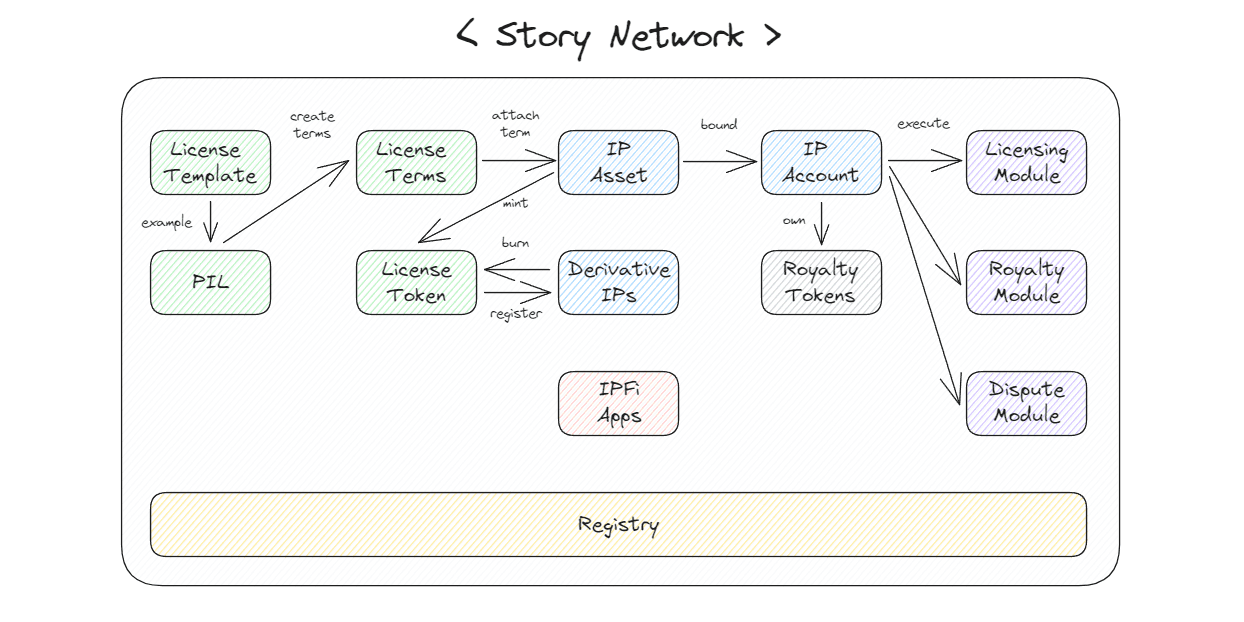
Story Protocol contains many terms that may confuse new users and developers. Understanding these terms and their relationships is crucial for grasping the overall concept. Here is a preliminary overview of these terms, and we will further explore how they interact:
- Story Network: The core blockchain of Story, built on the Cosmos SDK and compatible with EVM.
- IP Assets: IP registered on the Story Network exists in the form of ERC-721 NFTs, following metadata standards specifically designed for IP, including information such as the author, relationships with other works, and attributes.
- IPFi: DeFi applications based on various IP assets within the Story ecosystem.
- IP Account: After an IP asset is registered, an ERC-6551 (Token Bound Account) deployed by the IP asset registry, uniquely bound to the IP asset. It stores data related to the IP (such as metadata, ownership information, royalty tokens) and executes modules.
- Module: A collection of various functionalities in smart contracts that can be executed by IP accounts. Key modules created by the Story team include the authorization module, royalty module, and dispute module.
- Authorization Module: Handles tasks related to authorization, such as generating authorization terms from authorization templates, attaching them to IP assets, minting authorization tokens, and registering derivative IPs.
- Authorization Template: Legal framework code containing terms such as commercial usage licenses, transferability, and royalty percentages.
- Programmable IP License (PIL): The first example of an authorization template created by the Story Protocol.
- Authorization Terms: Different variants generated based on authorization templates. For example, even if two terms are based on the same PIL, one may have a 5% royalty, while the other may have 10%.
- Authorization Tokens: ERC-721 NFTs that anyone can mint when the IP owner attaches authorization terms to an IP asset. These tokens can be burned to register derivative IPs.
- Derivative IP: IP assets that have a parent IP asset. For example, a comic created based on a specific BAYC NFT can be registered as a derivative IP of that BAYC.
- Royalty Module: Determines the income flow between parent IP and derivative IP. The parent IP has two sources of income: fees for authorization minting and royalties from derivative IPs.
- Liquid Absolute Percentage (LAP): A default royalty policy that defines the minimum royalty the parent IP should receive from its derivative IPs.
- Dispute Module: Manages disputes involving malicious IP assets.
- Registry: The IP account manages the data of specific IP assets, while the registry manages a broader state within the Story Protocol. The main registries include the IP asset registry, authorization registry, and module registry.
- IP Asset Registry: Manages the IPs registered on the protocol and deploys IP accounts upon IP registration.
- Authorization Registry: Manages operations related to authorization, such as registering authorization templates, attaching authorization terms to IP assets, and registering derivative IPs.
- Module Registry: Maintains a list of global modules and hooks.
Understanding these terms and their interactions can provide a better understanding of how the protocol utilizes blockchain technology to address current challenges in the IP market.
Examples
To better understand how the mentioned elements interact and function, we will illustrate through a few simple examples. Please note that these are hypothetical scenarios and not real cases.
Registering Original IP
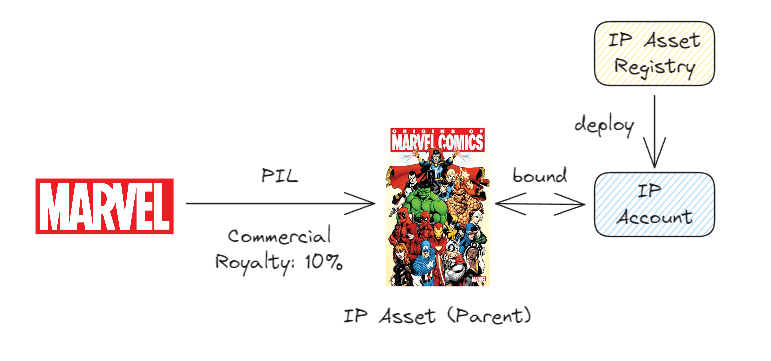
First, companies like Marvel can register their comics as intellectual property (IP) assets on Story. During the registration process, they can choose an authorization template (such as PIL) to set the usage terms for the IP. In this example, they choose to allow commercial usage of the IP by others and specify a 10% royalty to be paid for each usage. After registration, the system creates an exclusive account for the IP, and each IP asset will have 100 million royalty tokens for calculating the proportion of income it receives from derivative works (e.g., movies or merchandise based on the comic).
Registering Derivative IP
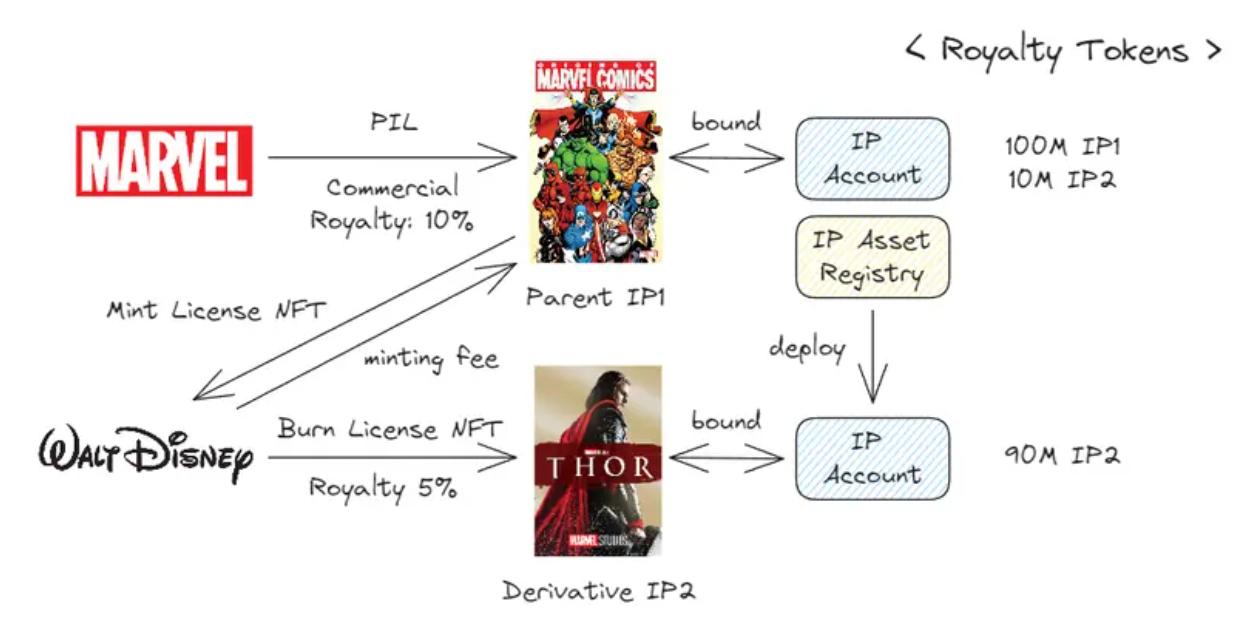
Next, Walt Disney decides to create a "Thor" movie based on Marvel's comic IP. For this, Walt Disney pays a fee (or zero fee) to mint an authorization NFT. Then, Walt Disney can burn this authorization NFT to register a derivative IP and specify the royalty percentage. Since Marvel has set a 10% royalty for the parent IP1, it will receive 10% from the 100 million IP2 tokens, i.e., 10 million IP2 tokens. Additionally, Marvel can receive 10% of the income generated by derivative IP2. It's worth noting that derivatives of the derivative IP can also be registered.
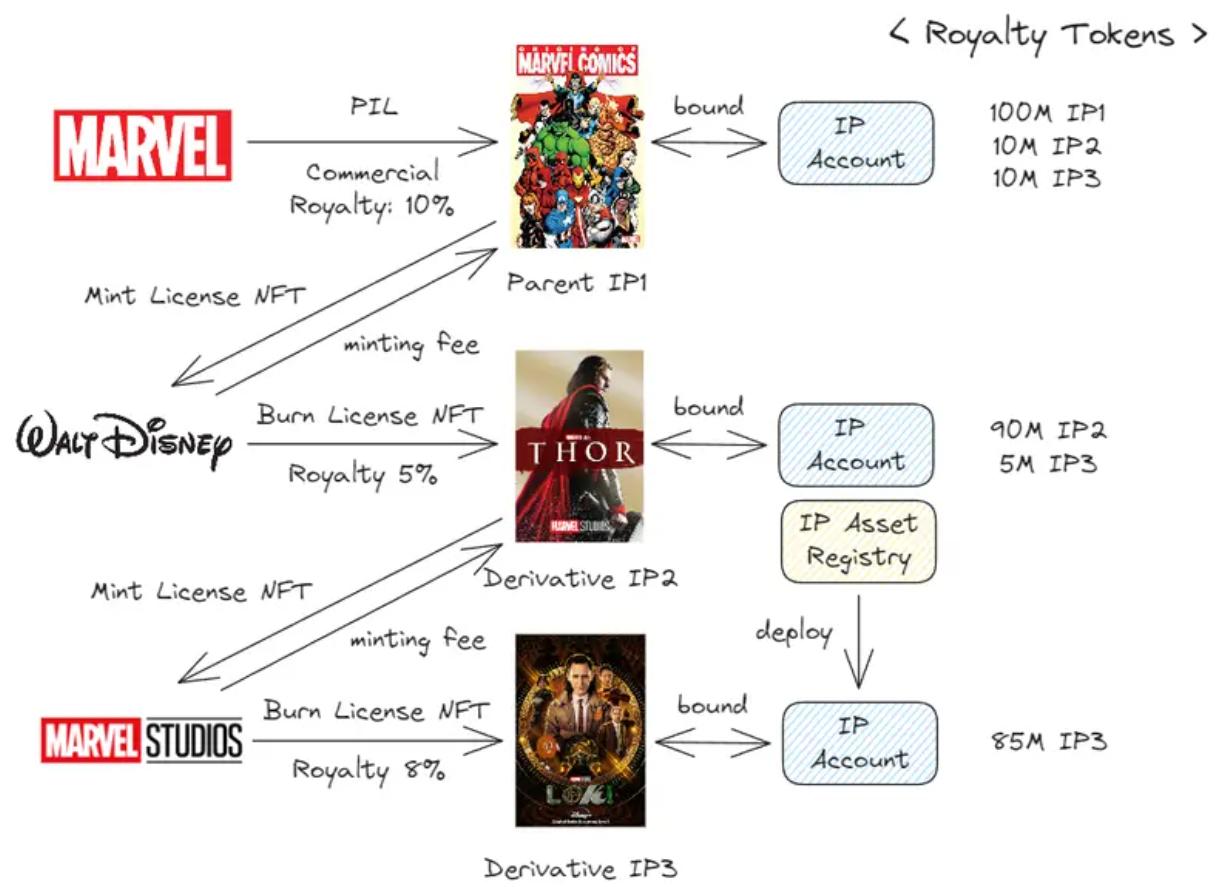
Income Structure
Each IP asset receives a proportion of royalty tokens from derivative IPs based on the set royalty percentage, representing a portion of its income. This mechanism follows Story's default royalty policy, LAP (Liquid Absolute Percentage). In this example, IP1 has a royalty percentage of 10%, and IP2 has 5%. This means that IP1 can receive 10% of the royalty tokens from IP2 and IP3, while IP2 can receive 5% of the royalty tokens from IP3. These tokens represent the share of income that IP assets can receive from their derivative works.
Disputes
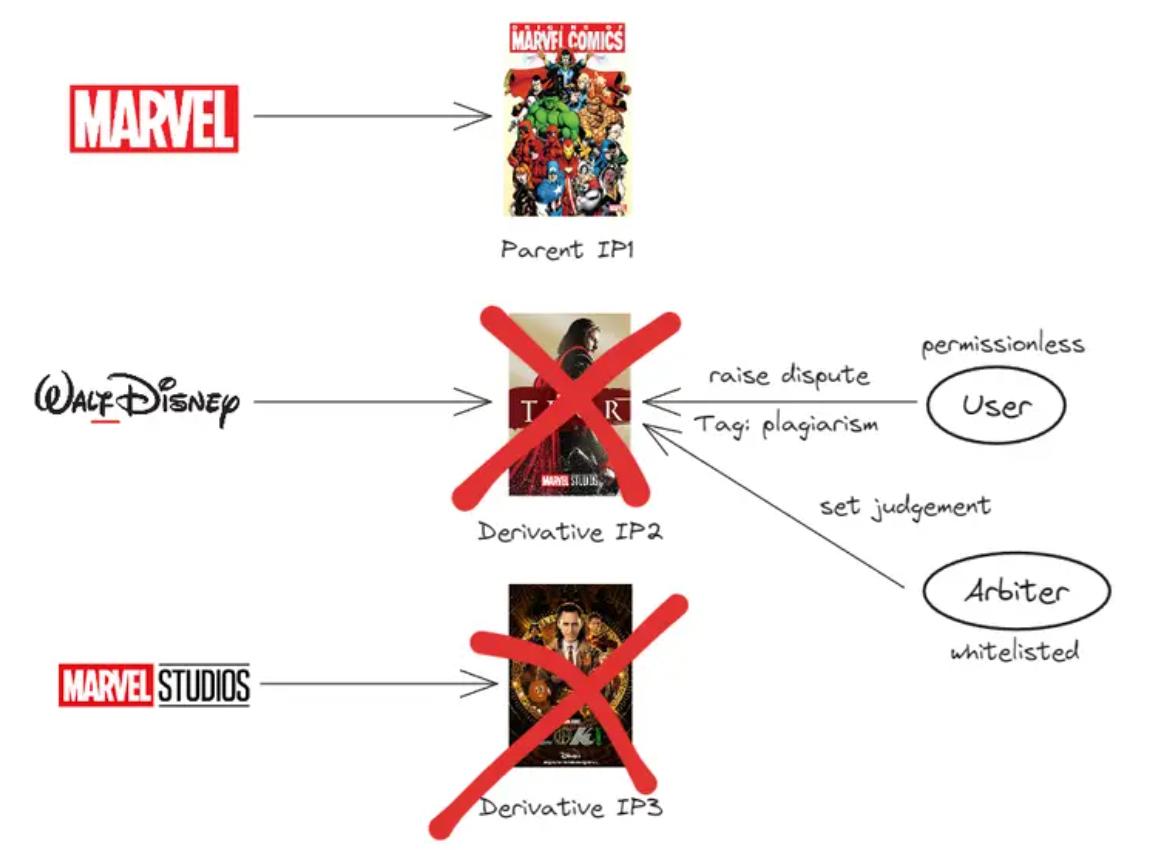
On the Story platform, unauthorized IPs may be registered, for example, an entity named "WalfDisney" registers a derivative IP2 related to Disney, raising concerns of plagiarism. In such a case, anyone can tag the IP and raise a dispute, which will be reviewed by whitelisted arbitrators who will make a ruling. Since legal issues of IPs belong to the real world and need to be resolved by relevant institutions, if an IP is deemed illegal, it will be marked as plagiarized, cease to receive income, and the tag will also apply to any related derivative IPs. If the illegal IP later resolves its legal issues, the disputant can remove the tag.
Current Ecosystem
Story Protocol not only makes IP registration and usage easier, more efficient, and transparent, but as an EVM-compatible blockchain, it also allows various applications to interact with IP. Let's take a look at some key applications within the Story ecosystem.
Creator Platforms
Magma is a collaborative art platform where creators can register their works as IP on Story; Sekai allows writers to integrate illustrations, audio, and music into their stories using generative AI and register the generated IP on Story for monetization; ABLO is a platform for creators to collaborate with major brands in designing clothing, using generative AI for creation, and seamlessly integrating IP registration, royalty distribution, and IP investment through Story; Color is a marketplace within the Story ecosystem for trading various IPs and licenses.
DeFi / IPFi
Unleash is an IPFi platform that offers IP authorization issuance, splitting, IP launchpad services, and lending protocols; PIPERX is a decentralized exchange on Story for trading ERC-20 tokens; Ethena's USDe is expected to become the stablecoin on Story, with specific details yet to be announced; Verio supports the re-staking of PoS tokens on Story and promotes the vIP token liquidity as the certification of IP assets.
Artificial Intelligence
Mahojin is a platform for creating images using generative AI, where creators can earn income by modifying content through keyword blending, which is highly beneficial within Story's infrastructure; AI applications and chatbots created on MyShell can be registered as IP assets on Story; RingFence protects users' internet usage data and monetizes it by selling the data for AI model training.
Challenges and Dilemmas Faced by Story
Token Economics
Story's native token IP is currently mainly used for PoS staking and paying gas fees, similar to other tokens. However, the true value of Story lies in registering derivative IPs and paying royalties. Therefore, to better drive the network's development, IP token rewards should be provided to users participating in these core activities, promoting the early launch and long-term sustainable development of the network.
Although the token economic model for IP has not been publicly disclosed, based on its project introduction, it can be speculated that IP tokens will not only be used to secure PoS network security and pay gas fees but also reward creators who register derivative IPs and pay licensing fees, as well as creators who pay royalties to the parent IP. Additionally, creators of parent IPs that create value through derivative IPs will also be rewarded. Furthermore, a portion of the licensing fees and royalty income generated by the Story network will be distributed to IP token stakers.
By providing IP token rewards to creators of parent IPs and derivative IPs, Story can attract high-quality IPs and a diverse range of derivative IPs. However, as the future IP token rewards decrease, it is necessary to establish solid sources of income in advance to ensure that stakers receive substantial returns, achieving the network's sustainable development. Additionally, in designing the token mechanism, measures need to be taken to prevent fraudulent activities, such as creating IPs of no actual value or registering meaningless derivative IPs solely for the purpose of obtaining rewards. Furthermore, rewards must clearly distinguish between those generated from real income and those obtained through falsification.
However, when designing token utility, certain issues need to be considered. It is essential to avoid engaging in fraudulent activities solely for the purpose of obtaining token rewards, such as creating IPs or registering derivative IPs of no meaningful value, which do not contribute actual value. Additionally, even when rewarding activities that create value, it is crucial to carefully distinguish whether the generated income is genuine or merely a form of wash trading.
Introduction of IPs
The inclusion of well-known IPs could lead to a large number of derivative IPs, creating more value and forming a virtuous cycle, further attracting more IPs. However, as companies owning mainstream IPs may not fully understand the advantages of blockchain, the Story team needs to effectively persuade them. Additionally, the Story Foundation may provide financial support to attract these well-known IPs, but if the selection and quantity of funding are not carefully considered, it may have adverse effects on other token holders, requiring cautious handling.
Applications of AI
AI plays an indispensable role in Story, allowing creators to more easily create new content by combining generative AI with IPs registered on Story. However, AI models may need to protect the data they learn from to prevent leaks before payment. Therefore, when data is first registered on Story, a feature should be provided to keep it confidential, allowing access only to those who have paid the licensing fee.
Integration of Legal and Regulatory Aspects
The Story platform cannot directly prevent unauthorized use of IPs, thus requiring the establishment of a comprehensive legal dispute resolution process. This process should cover both on-chain and real-world legal means to effectively address disputes and protect intellectual property when malicious behavior is detected.
免责声明:本文章仅代表作者个人观点,不代表本平台的立场和观点。本文章仅供信息分享,不构成对任何人的任何投资建议。用户与作者之间的任何争议,与本平台无关。如网页中刊载的文章或图片涉及侵权,请提供相关的权利证明和身份证明发送邮件到support@aicoin.com,本平台相关工作人员将会进行核查。




